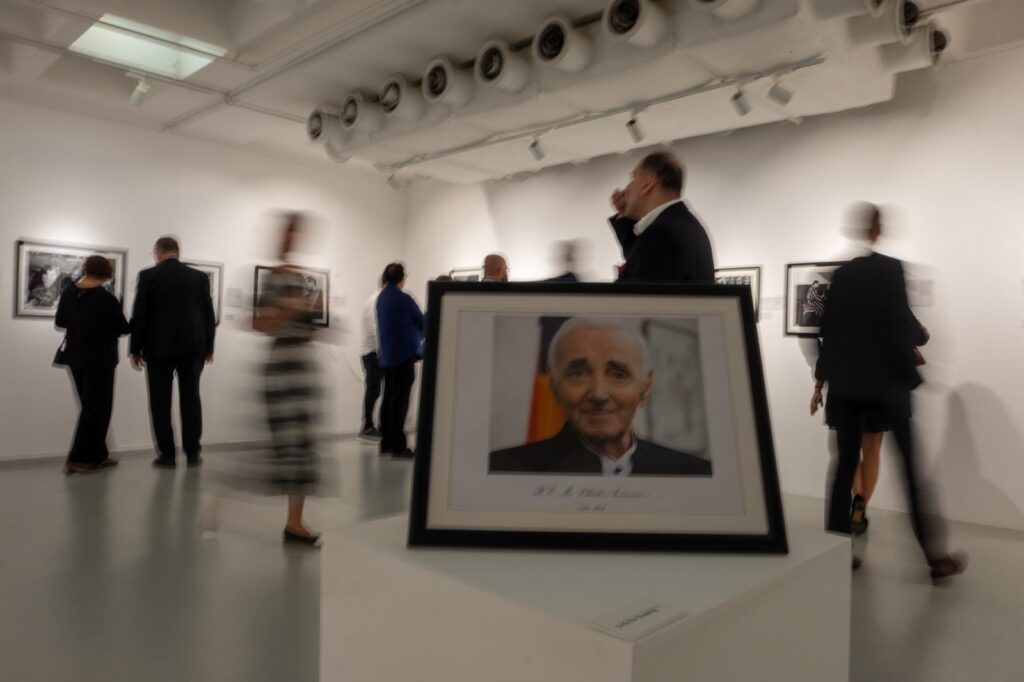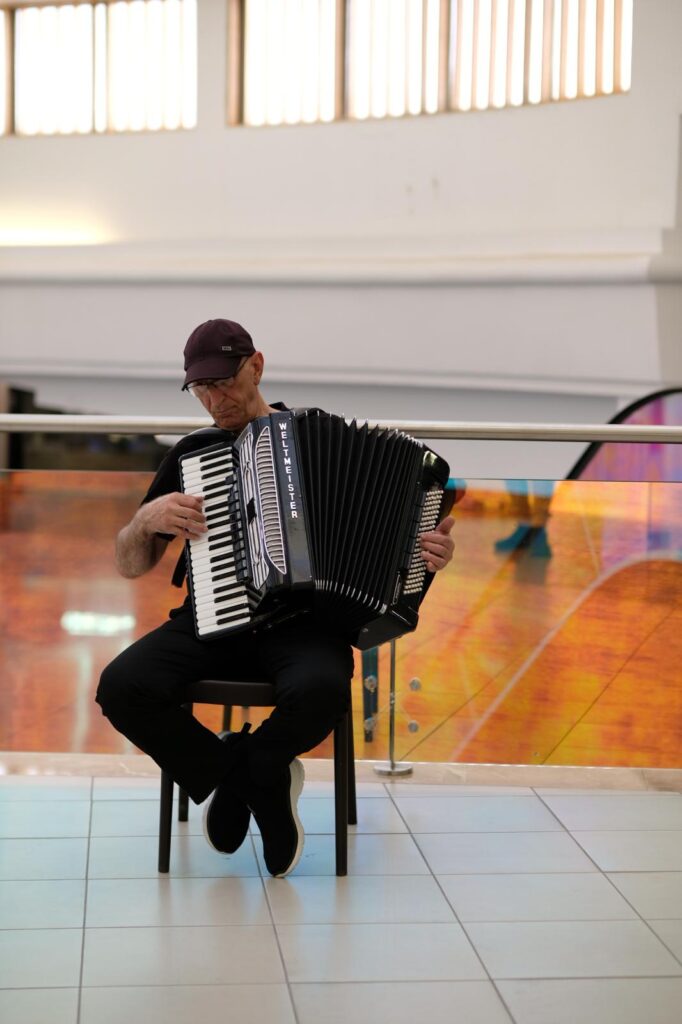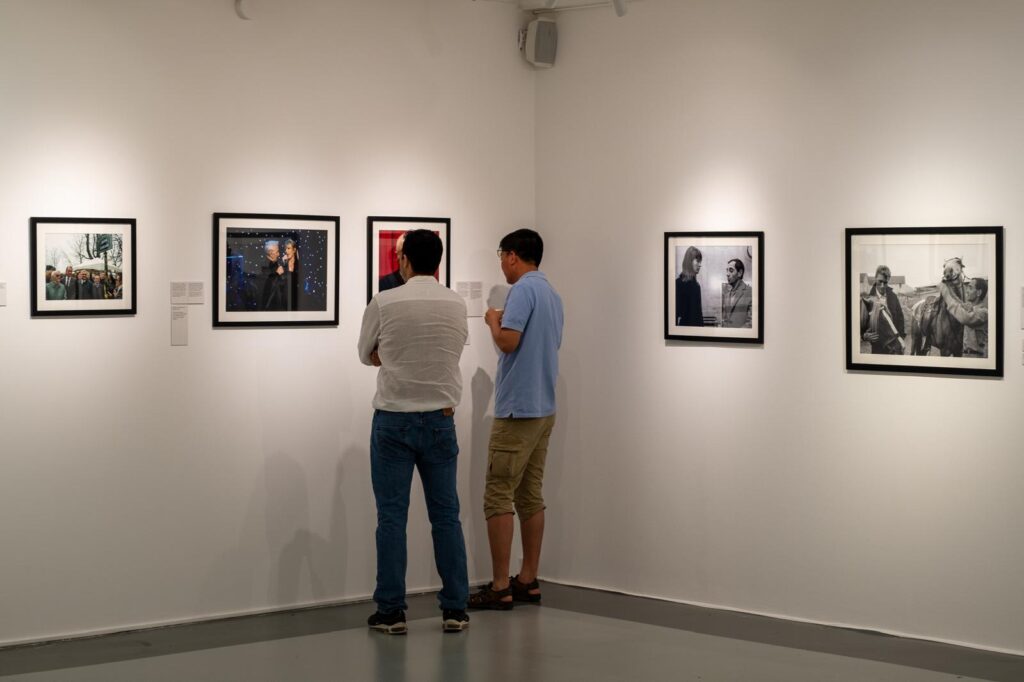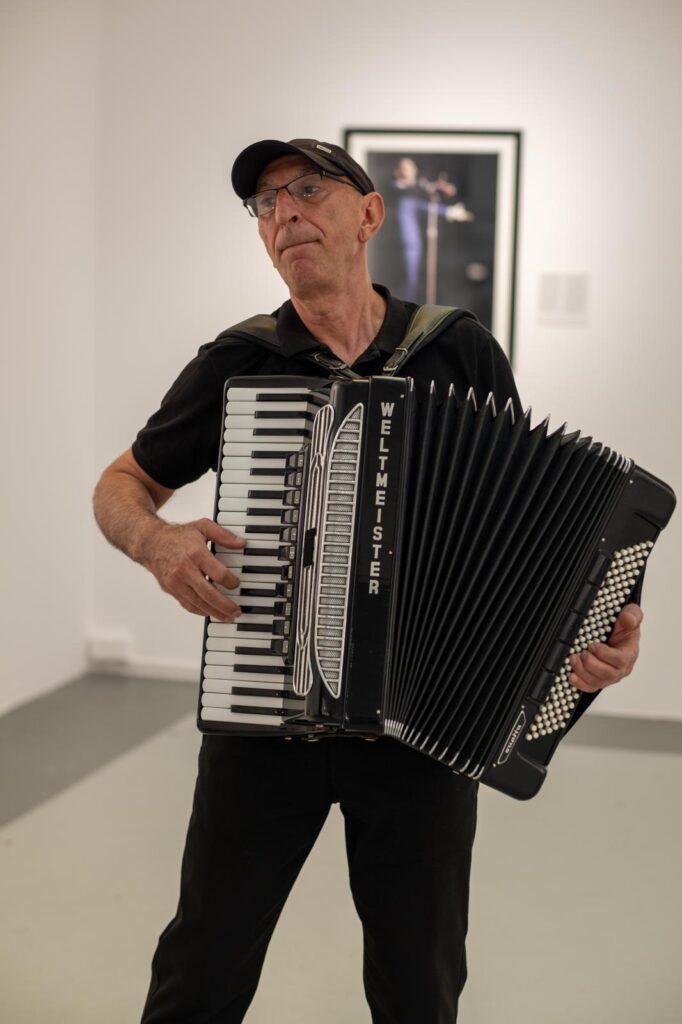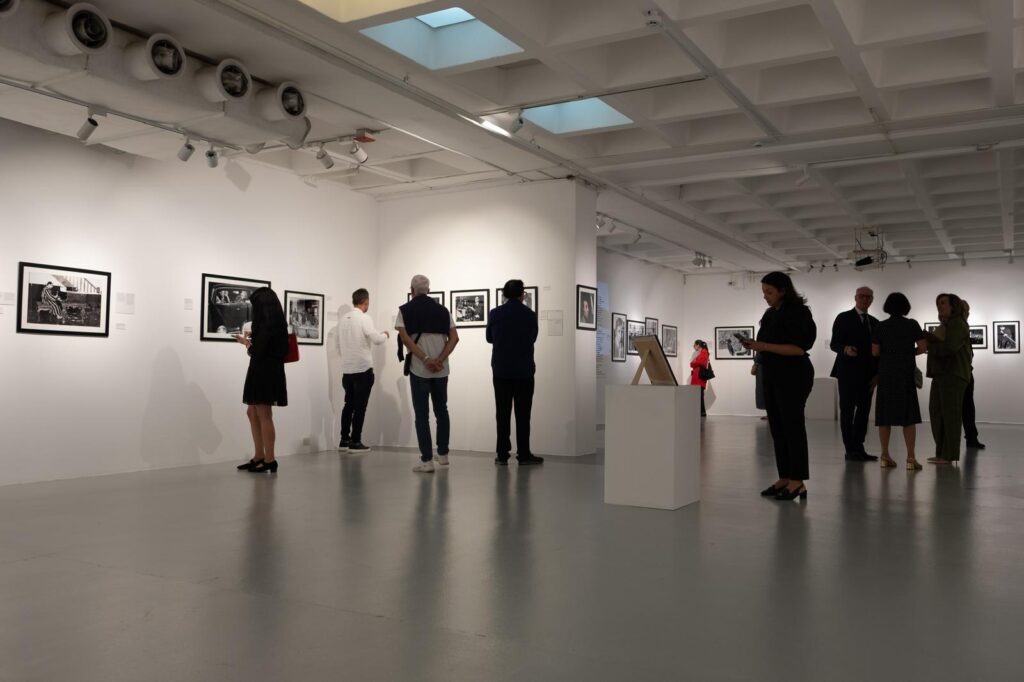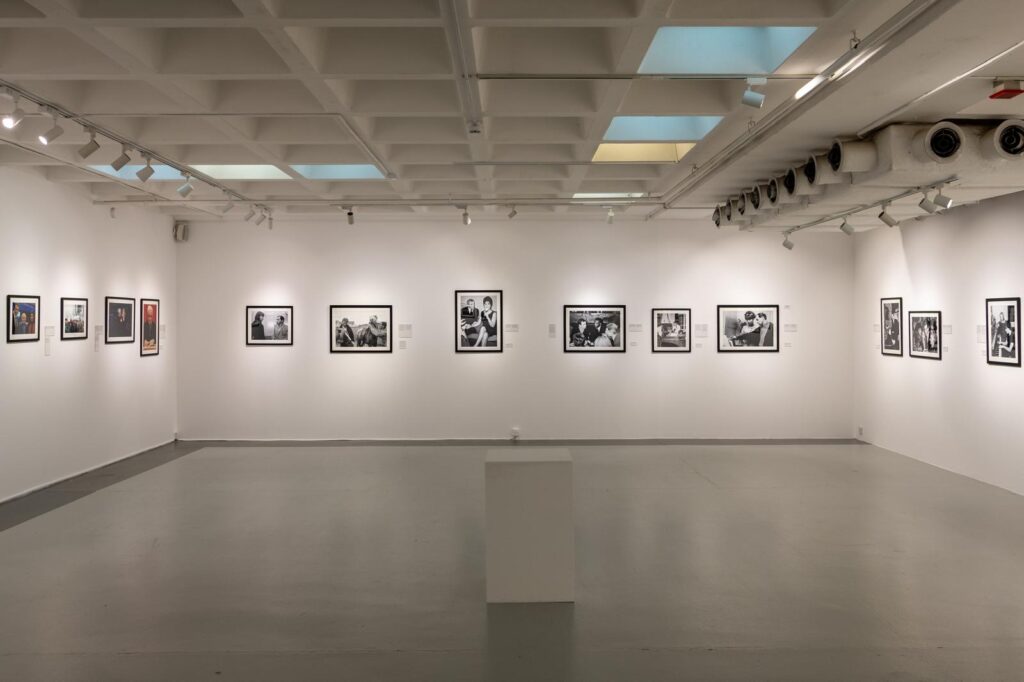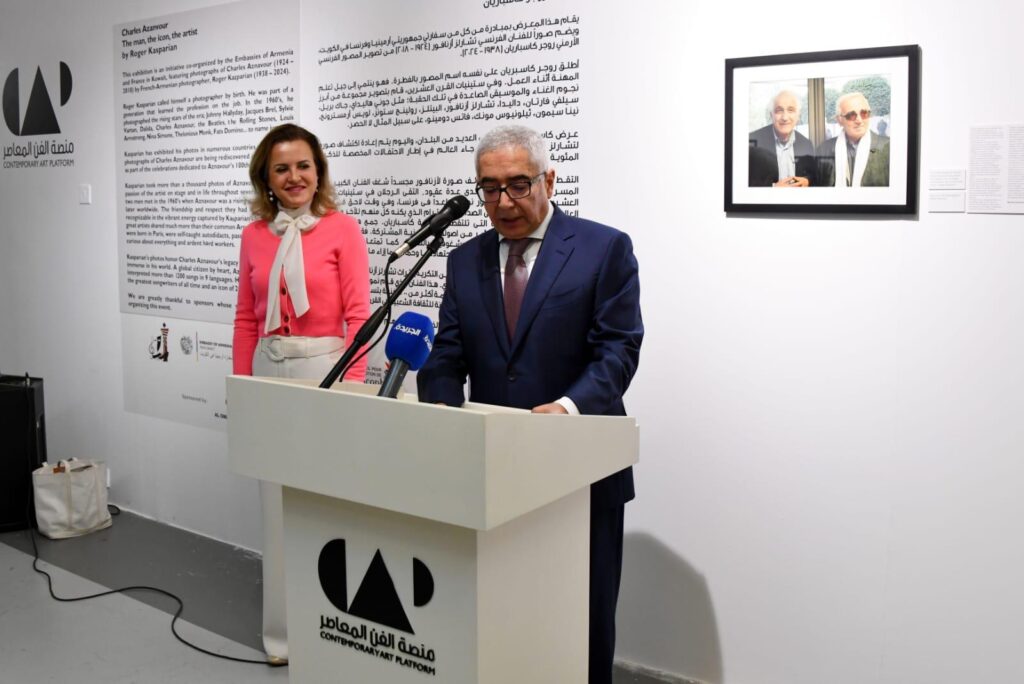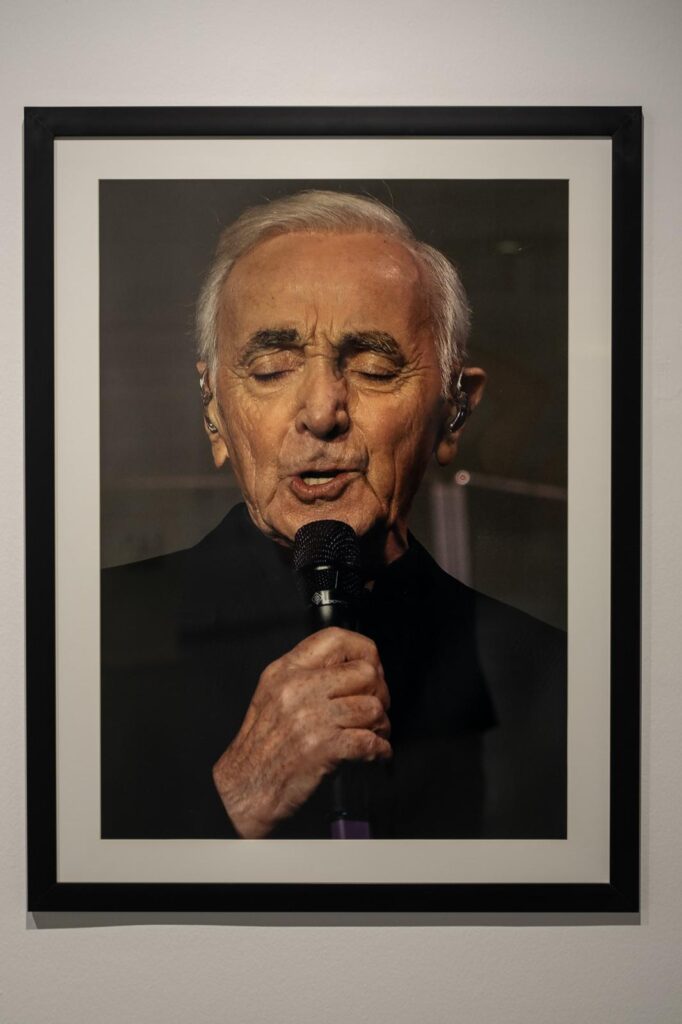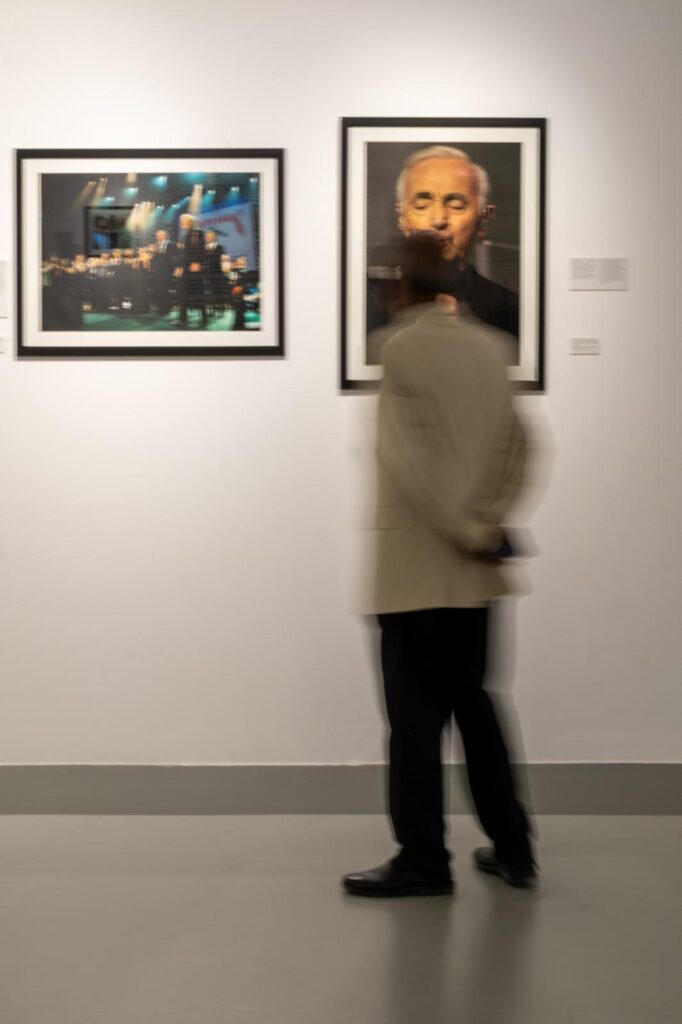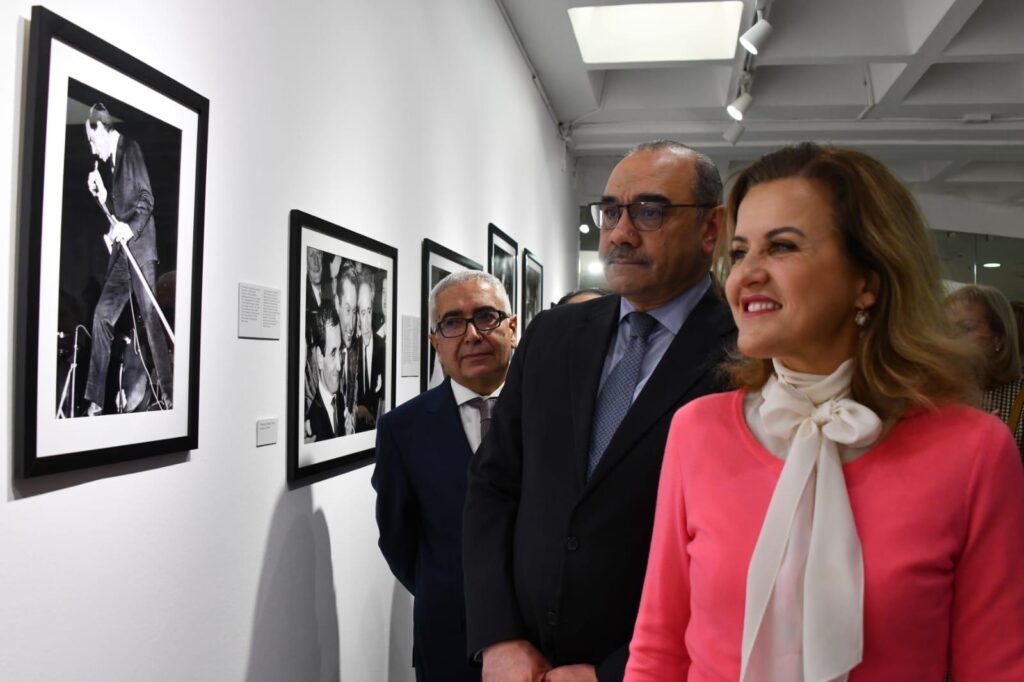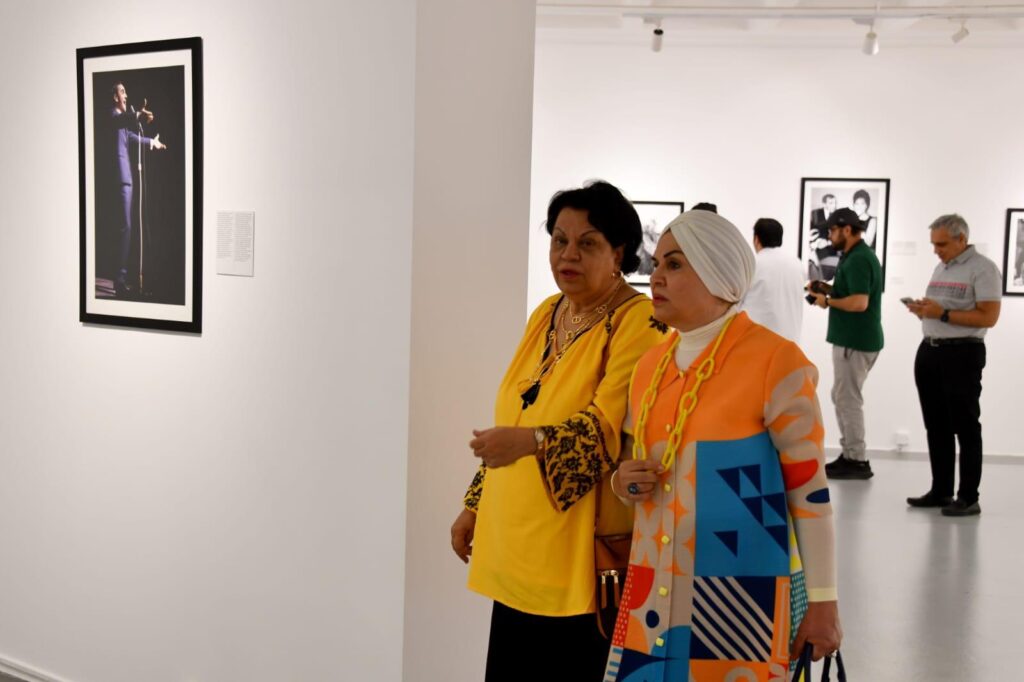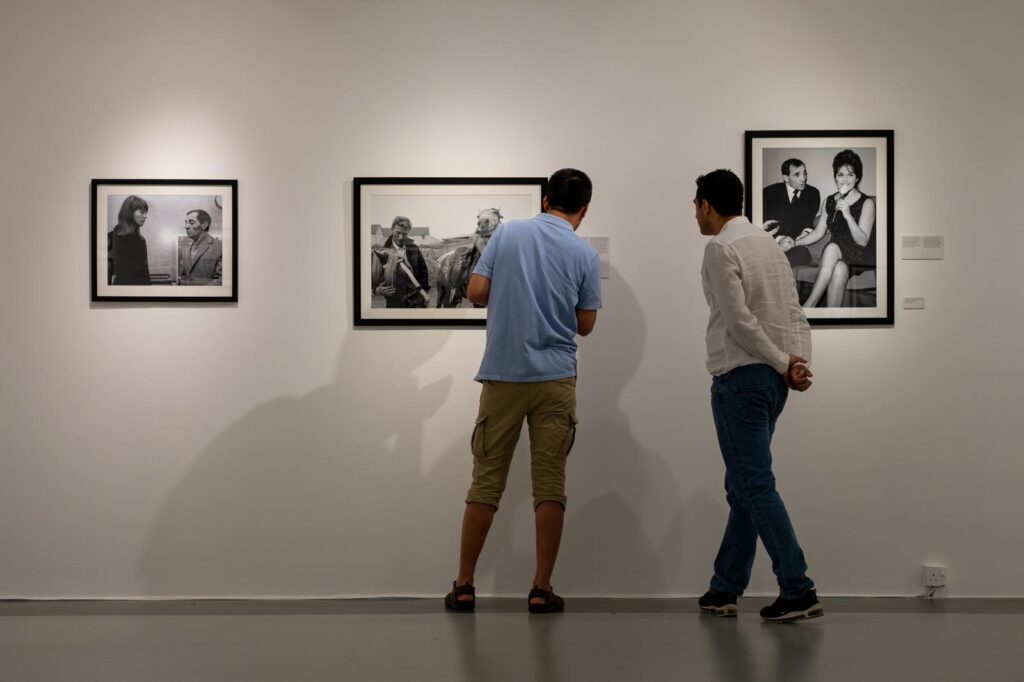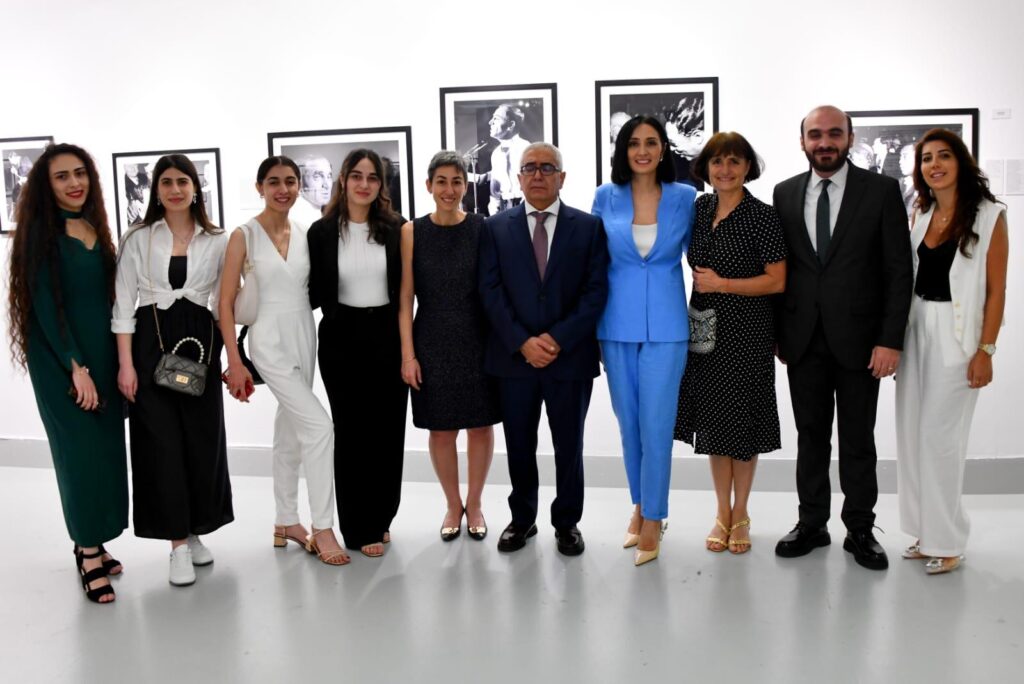CHARLES AZNAVOUR: The Man, The Icon, The Artist by Roger Kasparian
Exhibition Dates
- June 4, 2024
- August 1, 2024
Artist / Curator
Charles Aznavour's 100th Anniversary Celebration : Roger Kasparian
About Artist
This exhibition is an initiative co-organized by the Embassies of Armenia and France in Kuwait, featuring photographs of Charles Aznavour (1924 – 2018) by French-Armenian photographer, Roger Kasparian (1938 – 2024).
Roger Kasparian called himself a photographer by birth. He was part of a generation that learned the profession on the job. In the 1960’s, he photographed the rising stars of the era; Johnny Hallyday, Jacques Brel, Sylvie Vartan, Dalida, Charles Aznavour, the Beatles, the Rolling Stones, Louis Armstrong, Nina Simone, Thelonious Monk, Fats Domino… to name just a few.
Kasparian has exhibited his photos in numerous countries and today his photographs of Charles Aznavour are being rediscovered across the world as part of the celebrations dedicated to Aznavour’s 100th anniversary.
Kasparian took more than a thousand photos of Aznavour capturing the passion of the artist on stage and in life throughout several decades. The two men met in the 1960’s when Aznavour was a rising star in France and later worldwide. The friendship and respect they had for each other is recognizable in the vibrant energy captured by Kasparian’s lens. These two great artists shared much more than their common origins. Both were born in Paris, were self-taught autodidacts, passionate about culture, curious about everything and ardent hard workers.
Kasparian’s photos honor Charles Aznavour’s legacy and allow the public to immerse in his world. A global citizen by heart, Aznavour composed and interpreted more than 1200 songs in 9 languages. He is regarded as one of the greatest songwriters of all time and an icon of 20th-century pop culture.
EXPOSITION AZNAVOUR KUWAIT 4TH JUNE 2024
AZNAVOUR the man, the icon, the artist
by ROGER KASPARIAN
– AZNAVOUR ON STAGE
– AZNAVOUR BACKSTAGE
– AZNAVOUR STUDIO RECORDING, BUSINESSMAN
– AZNAVOUR WITH FAMILY
– AZNAVOUR AND HIS FRIENDS
– AZNAVOUR CULTURAL AMBASSADOR
- AZNAVOUR ON STAGE

On December 12th 1960, at the Alhambra, a legendary Parisian concert hall, Charles Aznavour definitively propelled himself to the top of the charts. It was on this occasion that Aznavour created his song “J’me voyais déjà” (I can already see myself) during a genius production where he appeared on stage in a shirt, in order to mimic the failed career of a singer who thought he was talented. With this almost autobiographical text, Aznavour completely won over his audience. This was the first meeting of the photographer Roger Kasparian with Aznavour. The previous month, in November 1960, the release of François Truffaut’s movie “Tirez sur le pianiste” (Shoot the piano player) had put Aznavour in the spotlight in the main role and All Paris was buzzing about Aznavour as an actor. But it was with this famous concert during the Premiere at the Alhambra that his notoriety really exploded. That evening, many famous people attended the event: Dalida, Jean Cocteau, Charles Trenet, in addition to Louis Armstrong, Duke Ellington accompanied by their wives, and many other personalities.

At the end of the concert on December 12, 1960, at the Alhambra, Charles Aznavour’s smile expressed his satisfaction of this enormous success. He is congratulated here by the singer Charles Trenet and by Jean Cocteau, poet, novelist and painter. This concert truly launched the musical career of Charles Aznavour. Charles Aznavour had a true admiration for Charles Trenet, another essential figure in French song.

American jazz pianist and composer Duke Ellington kisses the hand of the famous singer Dalida. Personalities from All Paris and major international stars were invited on December 12, 1960, to the Alhambra by Aznavour with the aim of boosting his career: Louis Armstrong and his wife, Duke Ellington, Dalida, the actresses Michèle Morgan, Annie Girardot, Jacqueline Boyer, the singer Philippe Clay, Marcel Achard, Jean Cocteau, Charles Trenet etc… At 36 years old, Charles Aznavour obtained recognition from everyone for his immense talent.

Olympia Concert Hall 1962, Aznavour, a true man of the stage, confirmed his successes on numerous occasions in this performance hall which saw the launch of many stars in the 60s. Aznavour sang there for the first time in 1955 as the opening act for Sidney Bechet, an American jazz super star who lived in France.

On the stage of the Alhambra, in the 60’s, Aznavour sang “Sa Jeunesse”, (My youth). Aznavour was an artist, a composer of rare talent who was always twenty years old in his own way: an example of success and accomplishment in the face of adversity and the timeless challenges of life. Roger Kasparian remembers that “although the son of immigrants, Aznavour mastered the French language admirably. His words were very elaborate and very visual, when you listened to them, you immediately saw images passing by.” Aznavour, although self-taught having left school at 10-and-a-half-years-old, read a lot, admired Victor Hugo, Jean de La Fontaine and Molière, who were pillars of French culture. Aznavour had fun saying that he had 3 dictionaries for his bedside books. Aznavour was a self-taught man who was interested in everything and loved words and verbal interplays.

On stage at the Olympia in the 1960s, Aznavour already showed his tremendous love for the public and the stage. He felt extremely happy and at home. During his 70-year career, Aznavour sang more than 1,300 songs in 8 languages and sold 200 million albums. Still at the age of 94, he was embarking on a new world tour when death surprised him in the middle of action and projects. During his long career, Charles Aznavour has given hundreds of concerts in dozens of countries and won over an international audience. Aware of the quality of the French texts, Charles Aznavour translated his songs into English, German, Spanish, Russian… A poll carried out by CNN and Times Magazine in 1998 named Aznavour the most important singer of the 20th century ahead of Bob Dylan, Franck Sinatra, Elvis Presley…

On television sets, Aznavour in the early 70s. Aznavour, as a true professional, had an exceptional gift of concentration. Charles Aznavour always wanted to sing and write. He was a hard worker, a complete artist. As he himself said with great modesty: He “lived as a dilettante but worked like an artisan”.

March 23, 1964, Charles Aznavour wearing a chapka, the famous Russian hat, at Orly airport upon his arrival in France after his triumphal Tour in the USSR. Very popular with the Russian public, Aznavour sang in Russian, a language he knew thanks to his father Misha, born in Georgia, and who spoke Armenian and Russian at home.

On December 2017, at 93 years old, Aznavour delighted more than 10,000 spectators on the stage of the Accorhotels Arena. The dean of French song, singer-songwriter, actor, writer and diplomat. Charles Aznavour has composed more than a thousand songs, sold nearly 200 million records worldwide and performed in concerts in 94 countries, often celebrated as the “greatest artist of the century.”


During the concert in AccorHotels Arena in Paris-Bercy, his daughter Katia Aznavour accompanied him in a duo song. As Roger Kasparian testified, for almost two hours, Aznavour will give EVERYTHING to his audience for his last concert in Paris. And yet, this was not Aznavour’s last concert. At 94 years old, insatiable, he left for a new tour and returned from Japan a few days before his death.

In 2017, photographer Roger Kasparian and Charles Aznavour, two artists who shared the same origins, were passionate about their art, and who worked until the last day.
- AZNAVOUR BACKSTAGE

At the Olympia, in his dressing room decorated with telegrams of praise and gratitude, Aznavour calmly prepares to enter the stage.

Backstage at the Olympia, Aznavour relaxes by playing on the upright piano that he had installed with a record player and a radio. The pre-concert atmosphere backstage was calm and serene. Roger Kasparian, who often accompanied and photographed Charles Aznavour backstage before a concert, tells us: “Aznavour never gave me the impression of being subject to stage fright.” Aznavour went on stage very young: at the age of 9, he joined a theatrical troupe in which he played but also danced and sang. Very quickly he wanted to become a comedian and a singer and he started writing lyrics as a kid. He had a genius for melodies. However, success took a long time to come and Aznavour began his career in cinema before meeting Edith Piaf who taught him a lot and took him to a tour in the USA. These experiences and above all his exceptional tenacity have made him an extraordinary artist.

Charles Aznavour in the 1960s behind the scenes at the Olympia. Roger Kasparian remembers “At the turn of the 50s and 60s, a little Armenian was starting to make a name for himself. We were listening to his songs on the radio. His texts and music spoke to us, young people. His songs talked about things like Sunday boredom and love. As Armenians, it lifted our morale. Because at the time, no one was talking about Armenia and the genocide. However, Aznavour did not want to be a singer of the diaspora: he wanted above all to be a French singer and was careful not to let himself be locked into a communitarian box. Aznavour was proud to tell that he was 100% French and 100% Armenian.”

Aznavour’s family accompanied him everywhere, even backstage at the Olympia. Knar, Aznavour’s mother, is at his side surrounded by congratulatory telegrams pinned to the wall.
- AZNAVOUR STUDIO RECORDING, BUSINESSMAN


Charles Aznavour at the Barclay recording studio in the early 1960s. “It was his songs that carried him. It was neither his physique, nor his height, nor his voice, but it was his lyrics and his music that remained. For a long time, others have sung his texts, from Juliette Greco (I hate Sundays) to Johnny Hallyday and many more. And then suddenly we realized that all the songs of the moment that had meaning were by Aznavour.”

Les Studios Barclay were famous recording studios located in avenue Hoche in Paris. During recordings, Roger Kasparian remembers that in the song “Bon Anniversaire” (Happy Birthday), the mention “Fermeture Eclair” (Zipper) in the Aznavour text is a registered trademark and cannot be used. So Aznavour had to stop the recording. But ultimately on the disc, the initial version is retained. Here, Aznavour records with Raymond Lefebvre’s orchestra.

Aznavour at work with his brother-in-law, Georges Garvarentz, Aïda’s husband. Garvarentz composed many famous titles for Charles Aznavour but also for Johnny Hallyday, Sylvie Vartan, etc… Aznavour always worked with his family, his sister Aïda with whom he had an immense bond, his brother-in-law Garvarentz, and with his children. One of his daughters, Katia Aznavour often gave concerts with her father and Nicolas Aznavour, who accompanied his father on his tours, became the President of the Aznavour Foundation with his wife Kristina. Charles was raised in France with Armenian traditions, he attached great importance to family values.

Aznavour has written numerous autobiographies including “Retiens la vie” (Hold on to life), “Tant que battra mon coeur” (As long as my heart beats), “Le temps des avants” (the times of old days) , “A voix basse” (In low voice) …… On December 9, 2008, Aznavour signed his latest book. Aznavour liked to give the image of a businessman. He knew how to lead his career and media communications. Aznavour had created a publishing house called French Music.
Charles Aznavour – Actor


During the shooting of the movie “Les vierges” (The Virgins) of Jean-Pierre Mocky in 1962. Charles Aznavour, who was also an actor, often saw himself behind the camera.
During filming, between takes, Charles Aznavour played chess or was interested in what was happening, in the equipment, he was curious about everything. Later, he was always found with a camera slung over his shoulder or a camera in his hand. Aznavour said that singing was like photography. It was like a real-life short film.
Aznavour has played in 80 films (“Shoot the Pianist”, “A Taxi for Tobruk”, “The Virgins”, “The Ten Little Negroes”…).

Aznavour loved cinema and is here with Johnny Hallyday and his friends in his private screening room in Montfort L’Amaury.
- AZNAVOUR WITH FAMILY


Aznavour with his sister Aïda (from left to right), his mother Knar, his first son Patrick and his daughter Séda (in the background) during the Christmas party at the Armenian College of Sèvres.

Charles Aznavour, as a true oriental, attached paramount importance to family values. He always lived surrounded by his family and knew how to maintain a very united family. Here in his house in Mougins, his parents Misha and Knar, and his daughter Séda.

Charles Aznavour at his grand piano, in his property in Galluis near Montfort-l’Amaury in the early 1960s. In this house, there was also a projection room and a swimming pool. Roger Kasparian says: “Aznavour was very natural but also very professional and rigorous. He measured the time he gave to photographers and journalists. He who had struggled to break through was aware of his success. The value of work was fundamental: Aznavour was a hard worker and it showed, but… work was above all a real pleasure for him. »

Aznavour’s parents, Mischa and Knar Aznavourian, are two artists who fled the genocide perpetrated in 1915 and arrived in France in 1923. Charles’ parents will never forget their journey as refugees and survivors. Roger Kasparian: “Despite all difficulties of life, I always knew Mamikon (Mischa) Aznavourian, Aznavour’s father with a smile. He was a gentle man who exuded a lot of love and kindness.” Here, his daughter Seda is at the piano under the attentive and affectionate eyes of Knar, the mother of Charles Aznavour.

With his wife Ulla Thorsell in the Barclay Studio. Ulla Thorsell, of Swedish origin “did a lot of good” to Charles Aznavour, he always said that she was the woman of his life. They had three children: Katia in 1969, Mischa in 1971 and Nicolas in 1977. Ulla has constantly been at Charles’s side but always with great discretion.
- AZNAVOUR AND HIS FRIENDS

Johnny Hallyday and Charles Aznavour in Montfort-l’Amaury. “Johnny was the idol of young people and therefore a bit of my idol. Aznavour was a beacon. He had written “Retiens la Nuit” (Keep the night) for Johnny, a very beautiful song which had worked very well. In this photo, they are in Monfort L’Amaury, it’s the first time I took photos of Aznavour at home. I was sent to report by a newspaper, Paris Jour, I think. Johnny who was a great friend of Aznavour and lived at his home for two years at this property where there was a riding school for horses.”

Aznavour at the piano, at his side, Dany Saval, the future wife of Michel Drucker, an emblematic figure of the French audio-visual landscape since 1964 and host of several popular TV shows, was a great lifelong friend of Charles Aznavour.

During a party organized by Eddie Barclay, Aznavour is holding hands with his friend Dalida, the famous French singer. Dalida was Egyptian-born French and Italian singer and actress who performed and recorded in more than ten languages, including Arabic, Italian, Greek, German, French…

In this incredibly intimate scene, Aznavour sketches out some rhythms while Johnny improvises on the guitar and Aïda accompanies on the piano. Hallyday lived with Aznavour on his property near Monfort-l’Amaury. Aznavour supported Johnny’s career with several pieces of advice such as not forgetting to also make songs for old people! Charles Aznavour lived in the 1960s in Galluis, a few kilometers from Montfort-l’Amaury (Yvelines). He regularly came there to do his shopping or eat at the restaurant. Aznavour always liked to lead a frugal and simple life.

Aznavour and Art Blakey in a Parisian Jazz club. Blakey, a famous American jazz drummer, came to Paris in 1961 to make a recording. Aznavour always appreciated American jazz musicians and they greatly influenced his musical rhythms.
- AZNAVOUR CULTURAL AMBASSADOR

From left to right, Levon Sayan, Line Renaud, Charles Aznavour, Annie Cordy, Jean-Pierre Foucault a famous TV presenter. Aznavour has always had a large circle of friends in the world of entertainment and culture. His simplicity, his kindness, his humor and his love of life were part of his natural charm and charisma.

Aznavour with President François Hollande.

Former President of France Nicolas Sarkozy came to applaud Aznavour at Bercy during his last concert in Paris in 2017. Next to him the former President of Armenia Serge Sargysan, and former Minister of Culture and brother of former President of France François Mitterand, Frédéric Mitterrand.

Charles with his son Nicolas Aznavour and the Mayor of Paris, Anne Hidalgo, at the annual dinner of the CCAF (the organization of Armenian Associations of France).

As part of the year of Armenia in France, two concerts were organized at the initiative of Charles Aznavour. The first concert was organized in Yerevan in September 2006, the 2nd concert took place on February 17, 2007 at the Opéra Garnier in Paris with the Armenian Philharmonic Orchestra for the benefit of the children of Armenia. Charles Aznavour was on stage to share his greatest hits with André Manoukian, Séda Aznavour, Stéphane Bern, The Choir of Children from Armenia, Chimène Badi, Bénabar, Amel Bent, Dany Brillant, Patrick Bruel, Gérard Darmon, Michel Delpech, Liane Foly, Grand Corps Ma-lade, Nolwenn Leroy, Nâdiya, Florent Pagny, Axelle Red, Hélène Ségara & Elisa Tovati,..

Charles Aznavour attends, along with other members of the Armenian community, as well as figures from the French political world, the inauguration of the Garden of Yerevan, in the 8th arrondissement of Paris, March 12, 2009. Roger Kasparian testifies: “At the beginning, Aznavour did not want to be labeled an Armenian singer, but from the moment he had an international stature, he naturally became a sort of ambassador of Armenia in the world. After the earthquake which devastated the northern part of Armenia in 1988, he created the Aznavour association for Armenia and his commitment to the country of his ancestors has never stopped.”


Charles Aznavour, one of the biggest names in French song, died in October 2018 at the age of 94. His death caused immense emotions. Until the last moment of his life, Charles Aznavour was always very active. Returning from a tour in Japan, Aznavour had participated in the Journal Télévisé of France 2 Station, three days before his death. In a moving tribute at a state funeral, French President Emmanuel Macron said: “In France, poets never die.” In May 2019, a commemorative plaque was placed at 36, rue Monsieur le Prince in the Latin Quarter in Paris, where Aznavour grew up.
“Parce qu’en France les poètes ne meurent jamais” President Emmanuel Macron’s tribute to Charles Aznavour at Invalides October 2018.

Roger Kasparian and Charles Aznavour
Roger Kasparian, in his twenties, had the exceptional opportunity to photograph the greatest figures of the French and international music scene of the 1960s. Among these icons, we find names such as Gainsbourg, Brel, Françoise Hardy, Claude François, Johnny Hallyday, Sheila, Sylvie Vartan, the Beatles, the Rolling Stones, Nina Simone, Duke Ellington, to name just a few.
In 1960, during the premiere of Aznavour at the Alhambra, Kasparian had the opportunity to photograph my father for the first time. It was the beginning of a relationship of admiration and pride for Kasparian, who always considered the Great Charles, who persevered despite various obstacles, as an example to follow.
Born in Paris on May 22, 1924, Charles Aznavour became one of the most emblematic and popular figures in French music. His unique voice and the poetic depth of his songs have earned him worldwide fame. His popularity transcends generations with an exceptional career spanning more than 85 years.
Through his lens, Kasparian offers us a fascinating insight into his life and career. His photographs capture the very essence of the singer, revealing his emotions, passion and charisma. Thanks to his keen eye and technical mastery, Kasparian was able to immortalize key moments that shaped the trajectory of this musical giant.
Whether in black and white or color, each photograph tells a story, an emotion, a truth. Kasparian was able to create an intimate visual dialogue between the viewer and the artist, inviting us to explore a unique intimacy.
As audience members, we are transported to the intimacy of backstage, onstage during vibrant performances, and into private moments of reflection. Kasparian’s photographs are a precious testimony to musical and cultural history, and they pay tribute to an artist who left an indelible mark on the world of music.
This exhibition is a touching tribute to the exceptional career of my father and to the work of Roger Kasparian, a visionary photographer who captured the very essence of a man who enchanted the world with his unique voice and talent.
Let yourself be carried away by the timeless beauty of these photographs and immerse yourself in the captivating world of Charles Aznavour, thanks to the talented lens of Roger Kasparian.
by Nicolas Aznavour
Roger KASPARIAN, photographer
Roger Kasparian, born in 1938, is the son of Varastade Kasparian who, as an orphan, received a quality education in an orphanage in Loir-et-Cher managed by the Howard Karagheusian foundation of New York. Varastade then became a talented photographer after a stint as an operator in the famous Studio Harcourt in Paris. Roger followed his father’s footsteps by becoming a photographer too. Raised in his father’s photography studio, he called himself a photographer by birth. He left school at 12 to work in photography. Roger made black and white prints in the family laboratory while listening to France Culture broadcasts or the classes of the philosopher Jankelévitch on Radio Sorbonne.
In 1960, returning from military service, Roger expressed his talent and his innate sense of lighting by photographing the rising idols of the Sixties. Roger took advantage of the proximity and complicity that he shared with these artists to create splendid portraits of the Yéyés singers, the great musical poets, the Anglo-Saxon and Jazz singers, thus parading under his lens, Johnny Hallyday, Serge Gainsbourg, Jacques Brel, Sylvie Vartan, Dalida, Charles Aznavour, Claude François but also the Beatles, the Rolling Stones, the Who, the Beach Boys, Louis Armstrong, Nina Simone, Thelonious Monk, Fats Domino,… to name just a few.
Roger Kasparian also participated on several occasions at the Cannes Film Festival where he has immortalized the great stars of cinema such as Alain Delon, Jean-Paul Belmondo, Gina Lollobrigida, Sophia Loren, Marina Vlady, Catherine Deneuve, Romy Schneider, Michèle Morgan…
Roger Kasparian has exhibited his photos in numerous galleries around the world. His photographs of Charles Aznavour have a special meaning because these two great artists shared much more than their common Armenian origins. Both were born in Paris to parents who were immigrants and refugees in France. But also, both were self-taught autodidacts passionate about culture, curious about everything and they have always been hard workers., Charles Aznavour, when asked about his work ethics said, “success is “1% luck, 5% talent and the rest is hard work”. Like the Great Charles whom he admired so much, Roger Kasparian worked with passion until the last day of his life at 86 year old. Kasparian died in Akhaltsikhe in Georgia, the birthplace of Aznavour’s parents. He had his camera in hand and was doing a report on the Armenians of this part of the Caucasus.
Roger Kasparian will be remembered as a gentle and modest man with a great sense of humor. His clear gaze and his kindness are unforgettable for the people who knew or encountered him.
2024 will be for me the centenary year of the death of Charles Aznavour but also the year of the death of my father. This event brings together two great artists who, in their own fields, have been able to take their art all the way to the top.
by Lydia Kasparian

